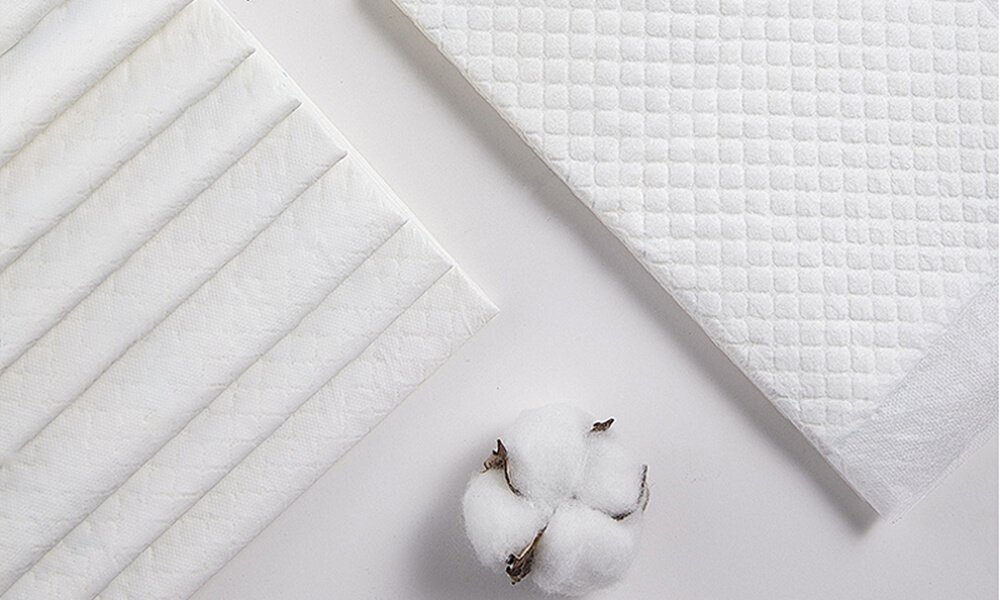Πίνακας περιεχομένων
Εισαγωγή στην Κρεβάτι μίας χρήσης Pad Βιομηχανία
Σημασία στον τομέα της υγειονομικής περίθαλψης
Τα κλινοσκεπάσματα μίας χρήσης έχουν γίνει απαραίτητα στις εγκαταστάσεις υγειονομικής περίθαλψης, παρέχοντας ουσιαστική υποστήριξη σε ασθενείς με διάφορες παθήσεις. Είναι σημαντικά για τη διατήρηση της υγιεινής και της άνεσης των ασθενών, ιδίως για τη διαχείριση της ακράτειας. Η αύξηση της γήρανσης του πληθυσμού και η επικράτηση των ιατρικών παθήσεων που απαιτούν τέτοια φροντίδα έχουν ενισχύσει σημαντικά τη ζήτηση για μαξιλάρια κρεβατιού μίας χρήσης. Συμβάλλουν καθοριστικά στον έλεγχο των λοιμώξεων και στη διατήρηση της αξιοπρέπειας των ασθενών, καθιστώντας τα ζωτικής σημασίας για τις υπηρεσίες υγειονομικής περίθαλψης.
Επισκόπηση της ανάπτυξης και του δυναμικού της αγοράς
Ο κλάδος των κλινοσκεπασμάτων μιας χρήσης παρουσιάζει ισχυρή ανάπτυξη, η οποία οφείλεται στην επέκταση του τομέα της υγειονομικής περίθαλψης παγκοσμίως. Αυτή η αύξηση της ζήτησης είναι εμφανής όχι μόνο στις καθιερωμένες αγορές αλλά και στις αναδυόμενες οικονομίες, όπου τα πρότυπα υγειονομικής περίθαλψης βελτιώνονται σταδιακά. Ο κλάδος επωφελείται επίσης από τις τεχνολογικές εξελίξεις στα υλικά και τις διαδικασίες κατασκευής, ενισχύοντας την αποτελεσματικότητα και την αποδοτικότητα. Η αυξανόμενη συνειδητοποίηση των αναγκών υγιεινής και υγειονομικής περίθαλψης τοποθετεί αυτό το τμήμα της αγοράς για σημαντική μελλοντική ανάπτυξη και επενδυτικές ευκαιρίες.
Εξέλιξη των μαξιλαριών κρεβατιού: Από το ύφασμα σε μίας χρήσης
Ιστορική προοπτική
Η μετάβαση από τα παραδοσιακά υφασμάτινα επιθέματα σε επιθέματα μιας χρήσης σηματοδοτεί μια σημαντική εξέλιξη στην υγειονομική περίθαλψη και την υγιεινή. Τα υφασμάτινα επιθέματα, που απαιτούσαν τακτικό πλύσιμο, ήταν λιγότερο αποτελεσματικά όσον αφορά την απορροφητικότητα και τον έλεγχο της οσμής. Η μετάβαση στις σερβιέτες μιας χρήσης αντιπροσωπεύει μια κρίσιμη πρόοδο στον τομέα της υγειονομικής περίθαλψης, η οποία οφείλεται στην ανάγκη για πιο υγιεινές, βολικές και αποτελεσματικές λύσεις.
Εξελίξεις που οδηγούν σε αναλώσιμα
Οι ανακαλύψεις στην επιστήμη των υλικών και στις τεχνολογίες κατασκευής επιτάχυναν τη μετάβαση προς τα μαξιλάρια μιας χρήσης. Η εισαγωγή υπεραπορροφητικών πολυμερών και οι βελτιώσεις στα μη υφασμένα υφάσματα μεταμόρφωσαν τον κλάδο, με αποτέλεσμα προϊόντα που προσφέρουν ανώτερη απορροφητικότητα, είναι ελαφριά και ενισχύουν την άνεση των ασθενών.
Εισαγωγές υλικού: μίας χρήσης
Ανάλυση των χρησιμοποιούμενων υλικών
Τα κλινοσκεπάσματα μίας χρήσης αποτελούνται συνήθως από πολλαπλά στρώματα που έχουν σχεδιαστεί για μια συγκεκριμένη λειτουργία. Το ανώτερο στρώμα είναι ένα μαλακό, μη υφασμένο ύφασμα για άνεση και γρήγορη απορρόφηση υγρών. Ο πυρήνας περιέχει υπεραπορροφητικά πολυμερή μέσα σε χνουδωτό πολτό, παρέχοντας αποτελεσματική απορροφητικότητα. Το κάτω στρώμα είναι συνήθως αδιάβροχο, αποτρέποντας τη διαρροή υγρών και προστατεύοντας τα κλινοσκεπάσματα και τα έπιπλα.
Ρόλος των υπεραπορροφητικών πολυμερών
Υπεραπορροφητικά πολυμερή (SAPs) αποτελούν τον πυρήνα των σερβιετών μίας χρήσης και είναι υπεύθυνες για την εξαιρετική απορροφητικότητά τους. Αυτά τα πολυμερή μπορούν να απορροφήσουν το βάρος τους σε υγρό αρκετές φορές, μετατρέποντάς το σε γέλη και αποτρέποντας τη διαρροή. Αυτό το χαρακτηριστικό είναι καθοριστικό για τη λειτουργικότητα των μαξιλαριών, προσφέροντας μια στεγνή και άνετη εμπειρία χρήσης και οδηγώντας στη συνεχή έρευνα και ανάπτυξη του κλάδου.
Διαδικασία κατασκευής: Βήμα-προς-βήμα οδηγός
Λεπτομερής περιγραφή των σταδίων παραγωγής
Η διαδικασία κατασκευής των μαξιλαριών μιας χρήσης περιλαμβάνει διάφορα βασικά στάδια. Ξεκινά με την προετοιμασία πρώτων υλών όπως μη υφασμένα υφάσματα και χνουδωτός πολτός σε συνδυασμό με υπεραπορροφητικά πολυμερή. Στη συνέχεια, τα στρώματα αυτά συγκολλούνται μεταξύ τους χρησιμοποιώντας μεθόδους θερμικής συγκόλλησης ή συγκόλλησης με υπερήχους για να σχηματίσουν μια συνεκτική δομή. Τα τελευταία στάδια περιλαμβάνουν την κοπή των μαξιλαριών στο κατάλληλο μέγεθος, τη συσκευασία και την προετοιμασία τους για διανομή.
Ενσωμάτωση της τεχνολογίας στη μεταποίηση
Η διαδικασία κατασκευής των κλινοσκεπασμάτων μίας χρήσης ενσωματώνει σε μεγάλο βαθμό την τεχνολογία για την αποτελεσματικότητα και τη διασφάλιση της ποιότητας. Ο αυτοματισμός και τα προηγμένα μηχανήματα εξασφαλίζουν σταθερή ποιότητα προϊόντων, ενώ η τεχνολογία βοηθά στον ποιοτικό έλεγχο, τον εντοπισμό και τη διόρθωση ελαττωμάτων. Αυτή η τεχνολογική ενσωμάτωση ενισχύει την παραγωγική ικανότητα και εγγυάται ότι τα μαξιλάρια πληρούν τα αυστηρά πρότυπα που απαιτούνται σε περιβάλλοντα υγειονομικής περίθαλψης.
Καινοτομίες στο σχεδιασμό κλινοσκεπασμάτων
Πρόσφατες βελτιώσεις σχεδιασμού
Η συνεχής καινοτομία είναι το σήμα κατατεθέν της βιομηχανίας κλινοσκεπασμάτων μίας χρήσης. Οι πρόσφατες εξελίξεις περιλαμβάνουν λεπτότερα, πιο απορροφητικά μαξιλάρια με πρόσθετα χαρακτηριστικά όπως ο έλεγχος της οσμής και οι δείκτες υγρασίας. Αυτές οι καινοτομίες βελτιώνουν την απόδοση του προϊόντος και ενισχύουν την άνεση και την ευκολία χρήσης του χρήστη.
Επιπτώσεις στην εμπειρία και τη λειτουργικότητα του χρήστη
Οι εξελίξεις στο σχεδιασμό των κλινοσκεπασμάτων βελτιώνουν σημαντικά την εμπειρία του χρήστη. Η βελτιωμένη απορροφητικότητα και ο έλεγχος των οσμών παρέχουν μεγαλύτερη άνεση και αξιοπρέπεια, ιδίως για τους χρήστες με προβλήματα ακράτειας. Χαρακτηριστικά όπως οι ενδείξεις υγρασίας βοηθούν τους φροντιστές στην έγκαιρη αλλαγή των επιθέματα, βελτιώνοντας τη φροντίδα των ασθενών και μειώνοντας τις επιπλοκές που σχετίζονται με το δέρμα.
Διασφάλιση ποιότητας στη μεταποίηση
Μέτρα ελέγχου ποιότητας
Κατά την κατασκευή κλινοσκεπασμάτων μίας χρήσης, η διασφάλιση της ποιότητας είναι υψίστης σημασίας, δεδομένης της εφαρμογής τους στην υγειονομική περίθαλψη. Οι κατασκευαστές εφαρμόζουν αυστηρά μέτρα ποιοτικού ελέγχου καθ' όλη τη διάρκεια της παραγωγής, δοκιμάζοντας την απορροφητικότητα, την ανθεκτικότητα και τη συμβατότητα με το δέρμα. Ο συνεπής ποιοτικός έλεγχος είναι ζωτικής σημασίας για να διασφαλιστεί ότι κάθε παρτίδα μαξιλαριών πληροί τα απαιτούμενα πρότυπα ασφάλειας και απόδοσης.
Σημασία της διατήρησης των βιομηχανικών προτύπων
Η συμμόρφωση με τα βιομηχανικά πρότυπα είναι ζωτικής σημασίας για τους κατασκευαστές κλινοσκεπασμάτων μίας χρήσης. Τα πρότυπα αυτά, που καθορίζονται από ρυθμιστικούς φορείς και ιδρύματα υγειονομικής περίθαλψης, διασφαλίζουν την ασφάλεια και την αποτελεσματικότητα των προϊόντων. Η τήρηση αυτών των προτύπων διασφαλίζει τους χρήστες και ενισχύει την αξιοπιστία και τη φήμη των κατασκευαστών στην αγορά της υγειονομικής περίθαλψης.
Περιβαλλοντικές εκτιμήσεις και προσπάθειες βιωσιμότητας
Περιβαλλοντικές επιπτώσεις των μαξιλαριών μιας χρήσης
Το περιβαλλοντικό αποτύπωμα των κλινοσκεπασμάτων μίας χρήσης, ιδίως όσον αφορά την παραγωγή αποβλήτων και την κατανάλωση πόρων, αποτελεί σημαντική ανησυχία. Ως είδη μίας χρήσης, συμβάλλουν στα ιατρικά απόβλητα και η παραγωγή τους απαιτεί σημαντικούς πόρους, όπως νερό και ενέργεια.
Βιώσιμες πρακτικές στον κλάδο
Ως απάντηση στις περιβαλλοντικές προκλήσεις, ο κλάδος υιοθετεί βιώσιμες πρακτικές. Οι προσπάθειες περιλαμβάνουν:
- Χρήση ανακυκλωμένων και βιοδιασπώμενων υλικών.
- Βελτιστοποίηση των διαδικασιών παραγωγής για μείωση των αποβλήτων και της χρήσης ενέργειας.
- Εφαρμογή πρωτοβουλιών ανακύκλωσης.
Οι πρακτικές αυτές ελαχιστοποιούν τις περιβαλλοντικές επιπτώσεις και ευθυγραμμίζονται με την αυξανόμενη ζήτηση των καταναλωτών για βιώσιμα προϊόντα υγειονομικής περίθαλψης.
Δυναμική της αγοράς: Τάσεις και Συμπεριφορά των Καταναλωτών
Ανάλυση των τρεχουσών τάσεων
Διάφορες τάσεις διαμορφώνουν την αγορά κλινοσκεπασμάτων μίας χρήσης, συμπεριλαμβανομένης της αυξανόμενης εστίασης στην κατ' οίκον υγειονομική περίθαλψη και των αυξημένων δαπανών για την υγειονομική περίθαλψη. Υπάρχει αυξανόμενη προτίμηση για προϊόντα που προσφέρουν αυξημένη άνεση και ευκολία, γεγονός που ωθεί τον σχεδιασμό των προϊόντων και τις καινοτομίες των υλικών.
Κατανόηση των αναγκών και των προτιμήσεων των καταναλωτών
Για τους κατασκευαστές, η κατανόηση των αναγκών και των προτιμήσεων των καταναλωτών είναι ζωτικής σημασίας. Αυτό περιλαμβάνει την ικανοποίηση των διαφορετικών απαιτήσεων των διαφόρων ομάδων χρηστών, όπως οι ηλικιωμένοι, οι μετεγχειρητικοί ασθενείς και η φροντίδα της μητρότητας. Η εξισορρόπηση της λειτουργικότητας, της άνεσης και της οικονομικής προσιτότητας είναι το κλειδί για την αποτελεσματική ικανοποίηση αυτών των ποικίλων αναγκών.
Παγκόσμιο ρυθμιστικό τοπίο και συμμόρφωση
Επισκόπηση των κανονισμών σε διάφορες χώρες
Το ρυθμιστικό τοπίο για τα μαξιλάρια μιας χρήσης ποικίλλει παγκοσμίως, με διαφορετικά πρότυπα ασφάλειας, απόδοσης και επισήμανσης. Οι κατασκευαστές πρέπει να περιηγηθούν σε αυτούς τους κανονισμούς για τη συμμόρφωση, ιδίως στις διεθνείς αγορές.
Προκλήσεις της συμμόρφωσης σε διαφορετικές αγορές
Η συμμόρφωση σε ποικίλες αγορές αποτελεί πρόκληση, απαιτώντας την τήρηση συγκεκριμένων προτύπων υλικών, παραγωγής και συσκευασίας. Η μη συμμόρφωση ενέχει κινδύνους κυρώσεων και ζημιάς στη φήμη του εμπορικού σήματος, γεγονός που καθιστά αναγκαία την επένδυση σε κανονιστική εμπειρογνωμοσύνη και στρατηγικές συμμόρφωσης.
Προκλήσεις και ευκαιρίες στη μεταποίηση
Διερεύνηση των τρεχουσών προκλήσεων του κλάδου
Ο κλάδος αντιμετωπίζει προκλήσεις όπως οι πιέσεις κόστους, ο ανταγωνισμός και η ανάγκη για συνεχή καινοτομία. Οι κατασκευαστές παλεύουν επίσης με περιβαλλοντικές ανησυχίες και πολύπλοκα ρυθμιστικά περιβάλλοντα, που επηρεάζουν την παραγωγή και την πρόσβαση στην αγορά.
Ευκαιρίες για ανάπτυξη και καινοτομία
Παρά τις προκλήσεις αυτές, οι ευκαιρίες για ανάπτυξη και καινοτομία είναι πολλές. Η ανάπτυξη νέων υλικών και σχεδίων, η είσοδος σε αναδυόμενες αγορές και η αξιοποίηση της τεχνολογίας για βελτιώσεις στην κατασκευή αποτελούν το κλειδί. Οι συνεργασίες και οι συμπράξεις παρουσιάζουν επίσης νέες δυνατότητες ανάπτυξης και επέκτασης της αγοράς.
Τεχνολογικές εξελίξεις και μελλοντικές προοπτικές
Αναδυόμενες τεχνολογίες στη μεταποίηση
Οι τεχνολογικές εξελίξεις καθορίζουν το μέλλον της κατασκευής μαξιλαριών μιας χρήσης. Τα προηγμένα υλικά, η αυτοματοποίηση και η ανάλυση δεδομένων βελτιώνουν την αποτελεσματικότητα και την ποιότητα της παραγωγής. Οι καινοτομίες στα βιοδιασπώμενα και έξυπνα υλικά προσφέρουν συναρπαστικές προοπτικές για την ανάπτυξη προϊόντων.
Προβλέψεις για το μέλλον του κλάδου
Ο κλάδος των μαξιλαριών μιας χρήσης είναι έτοιμος για σημαντικές αλλαγές. Οι συνεχείς τεχνολογικές εξελίξεις, η αυξανόμενη περιβαλλοντική συνείδηση και οι εξελισσόμενες ανάγκες υγειονομικής περίθαλψης θα διαμορφώσουν το μέλλον του κλάδου. Η έμφαση στη βιωσιμότητα, την άνεση του χρήστη και τη συμμόρφωση με τις κανονιστικές διατάξεις θα συνεχίσει να οδηγεί στην καινοτομία και την ανάπτυξη της αγοράς.

